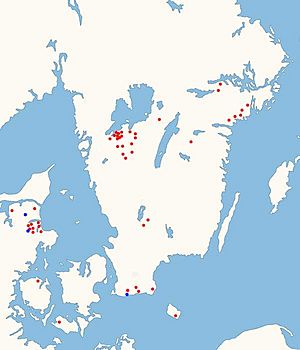Thegn facts for kids

In Anglo-Saxon England, around the 900s to 1000s, a thegn (pronounced thayn) was an important person. They were like a noble who owned a lot of land in one or more areas. Thegns were ranked high in society, just below the king and powerful leaders called ealdormen. The word thanage referred to both the land a thegn held and their special rank.
The word thane was also used in early medieval Scandinavia for a group of loyal followers. In eastern Scotland, a thane was a local royal official, similar in rank to an earl's child.
Contents
What is a Thegn?
The word thegn comes from the Old English word þeġ(e)n, which meant "man," "attendant," or "loyal follower." It's related to similar words in Old High German and Old Norse.
A thegn had an important military role. In Latin, the word was often translated as miles, meaning soldier. It could also mean someone who served a king or queen, either in their home or across the country. Over time, the word thegn started to describe a specific class of people with different levels of importance.
How Thegns Came to Be

Before the 900s, the common word for a noble was gesith. Some gesiths owned land, while others did not. A gesith who didn't own land would serve a king, queen, or lord. These lords were called hlaford, which means "bread-giver." In return for their loyalty, the gesiths received protection and gifts like gold and silver. Young nobles often grew up with the king's children, hoping to become their gesith one day. If a gesith served well, they might be given land as a reward.
Around the 900s, the word gesith was replaced by thegn. The word thegn started to appear more often in official documents. It seems that the idea of serving someone was always part of the word's meaning. Over time, it grew to describe a member of the land-owning nobility. You could even become a thegn by meeting certain conditions.
In Anglo-Saxon society before the Norman Conquest, nobles were ranked by the heriot they paid. This was a payment made to the king when a noble died. The order was: earl, then a king's thegn, and then a median thegn. King's thegns served the king directly and had their own followers. A "median thegn" held their land through another lord, not directly from the king.
The Status of a Thegn
A thegn had a higher social standing than a ceorl, who was a free peasant. From the time of King Æthelstan, the difference between a thegn and a ceorl was the main way society was divided. The higher status of a thegn was shown by their weregild, which was the amount of money paid if they were killed. A thegn's weregild was usually 1,200 shillings, which was six times more than a ceorl's.
Some people were born into the rank of thegn, but others earned it through owning property or becoming wealthy. A document called the Geþyncðo explained how a ceorl could become a thegn. It said that if a ceorl owned five hides (a measure of land) of their own land, had a church, kitchen, bell tower, and a special seat at the town gate, and served the king, then they were worthy of thegn-right. Merchants who traveled across the sea three times with their own goods could also become thegns. In the same way, a successful thegn might even hope to become an earl.
As the number of thegns grew, the group split into different levels. There were king's thegns, who were the most important, and a larger group of less important thegns. Some of these were thegns of bishops or even other thegns. King's thegns had special rights, and only the king had power over them. In Latin, a king's thegn was sometimes called a comes, which means "count". In the laws of King Cnut, king's thegns paid a larger heriot than regular thegns.
The difference between ordinary thegns and king's thegns was like the difference between a minor noble and a powerful Baron. It shows how a loyal follower of a warlord could become a more independent noble over time.
By the time the Domesday Book was created after the Norman Conquest, the Old English word þegn had become tainus in Latin. However, the word didn't always mean someone of high status anymore. The Domesday Book lists the taini who held land directly from the king, but the term had lost some of its importance, possibly because there were so many thegns.

Even though their exact role isn't fully clear, twelve senior thegns from each hundred (a local area) played a part in developing England's justice system. Under a law by King Aethelred, they seemed to act as a group that accused people in court. This might be an early link to the modern jury trial system.
After the Norman Conquest
After the Norman conquest of England in 1066, William the Conqueror took over. He replaced the Anglo-Saxon nobles with Normans. The Normans used their own names for social ranks. Those who were called thegns before the conquest became part of the knightly class.
Thegns on Runestones
In Denmark and Sweden during the late 900s and 1000s, families or friends often put up memorial runestones. About fifty of these stones mention that the person who died was a thegn. Some examples of these runestones include Sö 170 at Nälberga, Vg 59 at Norra Härene, Vg 150 at Velanda, DR 143 at Gunderup, DR 209 at Glavendrup, and DR 277 at Rydsgård.
See Also
- Abthain
- Fyrd
- Thain
- Thane (Scotland)
- Trinoda necessitas

